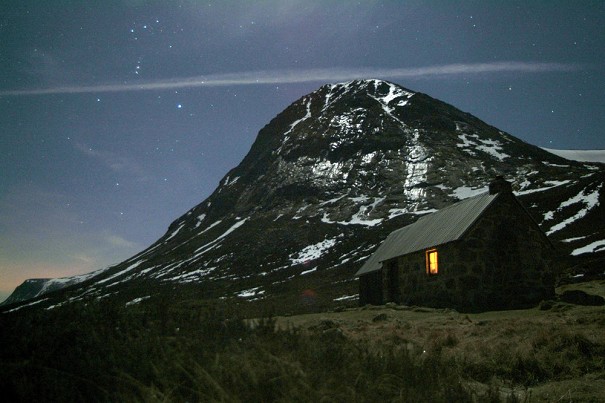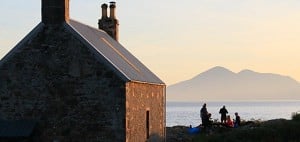
The spartan refuge huts once scattered across the high Cairngorms are a fascinating but tragic chapter in the history of the Scottish hills. Alan Rowan seeks out the last one standing.
The refuge is hard to spot, a modest construction in the chaos of a boulder-strewn slope high above the wild and lonely confines of Strath Nethy. El Alamein is a place found only by design or accident: you have to be actively looking for it or you have stumbled way off route. And the fact that it is so far off the beaten track is probably the reason it is still standing.
Most of the other rudimentary shelters in the high Cairngorms are long gone, torn down after the Feith Buidhe disaster of November 1971 when six members of a party from a school in Edinburgh – a trainee instructor and five pupils – died during a winter exercise on the plateau.
The rear wall has partly collapsed and part of the roof is gone, but I was delighted to see this piece of history still standing. It's a perfect spot to find solitude
On Saturday, November 20, a party of eight – six teenage schoolchildren and two young instructors, one a trainee – set off across the Cairn Gorm-Ben Macdui plateau in an attempt to reach Corrour Bothy in the Lairig Ghru.
Due to various problems and in rapidly deteriorating conditions, they were forced to bivouac beside a small river called the Feith Buidhe. This part of the plateau is a notorious place in bad weather, where the snow can be so deep and the going hard.
Another party from the same school had attempted a more ambitious route and were also forced to bivouac. They managed to reach the Curran bothy on the plateau and stayed the night. Despite the wild weather they eventually made it back to their base at Lagganlia expecting to find the rest of the group.
With no sign of the others, a huge search operation was put into place, with teams from Glenmore Lodge, Braemar, Cairngorm and RAF Kinloss all involved. Unfortunately, five children aged 15 and the trainee instructor died. One child and the adult instructor survived.
It was the worst accident in Scottish mountaineering history and it led to huge changes in safety procedures. One of the more controversial decisions was that these rough shelters in the high Cairngorms should be removed as their presence provided a false sense of security to the inexperienced. In wild weather they could be difficult to locate, sometimes invisible under deep snow cover, and the Fatal Accident Inquiry into the tragedy concluded that the existence of the Curran Bothy had caused the party to keep going to try to reach it when otherwise they might have turned back.
The Curran and the St Valery were eventually dismantled in 1975 after protracted and often heated arguments for and against their continued presence. The plaque for the St Valery shelter can still be found lying among the boulders on the slope above Stag Rocks where it once stood.
Jean's Hut and the Sinclair Hut have also gone. Jean's Hut, originally sited in Coire Cas and later moved to Coire an Lochain by a team of Ghurkas, had been gifted by Dr Alasdair Smith in memory of his daughter Jean who had died in a skiing accident. It had become increasingly dilapidated over the years and in 1984 became the focus for another tragedy when three walkers died trying to reach the safety of the hut. It was finally removed two years later.
The Sinclair Hut – or to give it its full name, the Angus Sinclair Memorial Bothy – was built in 1957 in a prominent position in the Lairig Ghru which meant it could avoid being buried by even the deepest snowfall. It later suffered from overuse and subsequent vandalism, and the added problems of recurring maintenance and a lack of funds saw it eventually disappear in 1991.
But while the Curran and the St Valery were removed for safety concerns, El Alamein's isolated and more remote location meant it was seen as less of a magnet for walkers and it was left alone. The positioning was believed to be accidental, a mix-up in map references leading to construction well below the rim of the corrie where it was supposed to have sat.
The refuge was built in memory of the 51st Highland Division who had fought at El Alamein in 1942, a pivotal battle during the Second World War that raged for 12 days. The division that fought in Egypt had been reformed after being captured at St Valery during the Dunkirk evacuation two years earlier.
The metalwork for the the skeletons of the El Alamein, Curran, St Valery refuges plus the shelter situated at the Fords of Avon were made by artificer apprentices from HMS Caledonia in workshops at Rosyth, led by SCM Jim Curran of the Royal Marines, then carried to the sites as part of military training exercises. The walls were then constructed around these frames.
A stone embedded in one of the walls reads 'El Alamein Refuge 1963' along with the badge of the division. A similar plaque lies at the former site of the St Valery refuge.
I have long been fascinated by these shelters and their history, and during a recent ascent of Cairn Gorm to celebrate the second anniversary of octogenarian Nick Gardner's amazing Munros completion I took advantage of the stunning conditions to go in search of El Alamein.
I had the grid references but even when I reached the col, it was impossible to spot the refuge amongst the boulder field down below from this height. I had been told there was a line of cairns marking the way further down but if they did exist, they have long ago been absorbed into the general rock chaos.
Despite its survival, El Alamein wouldn't offer much shelter from the storm these days: the rear wall has partly collapsed and is exposed to the elements and part of the roof is gone, but I was just delighted to see this piece of history still standing proud and the location is simply sensational. It's a perfect spot to find a little peace and solitude, in stark contrast to the busy summit area and ski apparatus on the other side of Cairn Gorm.
Sitting alone under a blue sky and brilliant sun with a long line of sight all the way up rugged Strath Nethy and across to the muscular presence of Bynack More, I did wonder how many take the time to visit this remote spot, or are even aware of it.
In these conditions, it would easy to be lulled into a false of security. When the winds are howling and the snow driving through, this could feel a desolate and even dangerous place. That reality was reinforced a few weeks later as we made our way out of Strath Nethy after a long circuit from Glen More via the shoulder of Bynack More in fierce winds that prohibited any thoughts of going higher.
We were on the last leg, the seemingly never-ending boggy flats where the valley widens, when I glanced over to the sweeping slopes on the left. Hidden somewhere up there in those seams of boulder confusion lay El Alamein. In our leg-weary state, it seemed inconceivable that anyone would consider this as a more tempting approach to Cairn Gorm unless they were specifically aiming for the refuge.
*My thanks to David 'Heavy' Whalley and Neil Reid for their input and expertise on this article.
















Comments
Were the bothies/shelters in Garbh Choire (Braeriach) and Fords of Avon ever considered for removal?
Used Jean's Hut a few times in the early 70s. Only drawback was the corrugated iron roof which resulted in terrible condensation and the floor could be swimming. But handily placed for climbing in the northern corries.
I can remember some discussion, particularly at a time when the Garbh Choire bothy was at a point when it was either letting it fall into ruin or to renovate it. But I can't remember if it was 'official' - & who would that be anyway ? Can anyone remember who removed the bothies dicussed in the article ?
The police?
http://www.cairngormclub.org.uk/journals/PDFs/Articles/J095/The%20Cairngorm%20Club%20Journal%20095%20-%20The%20Feith%20Buidhe%20disaster%20WM.pdf
The Garbh Choire in April 2010. No idea if it's still there.